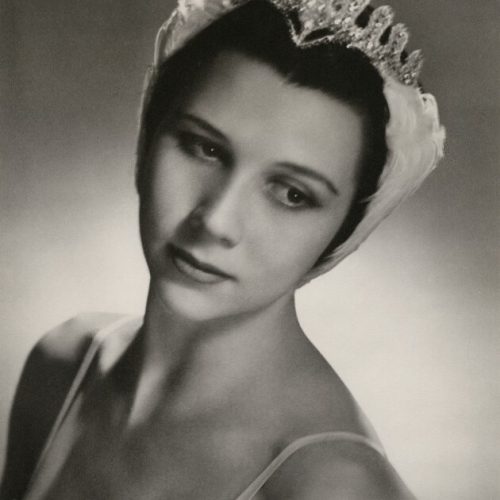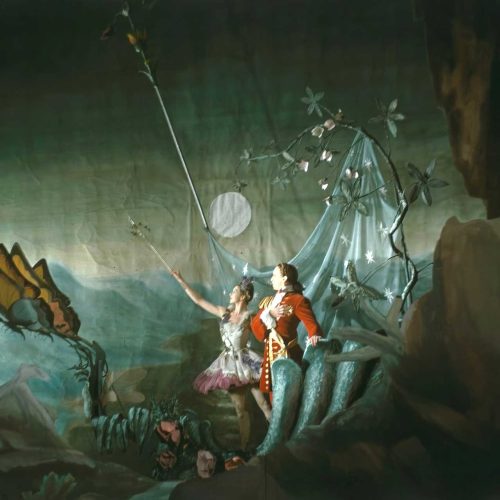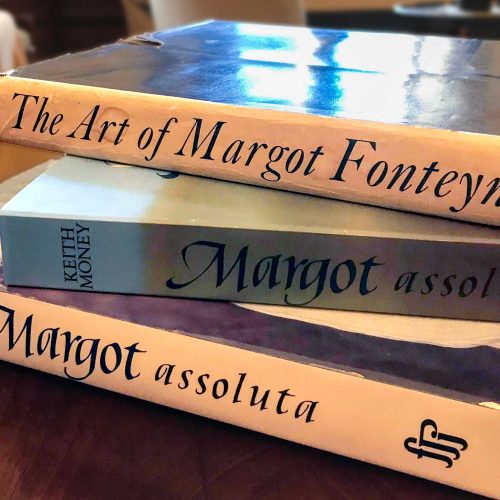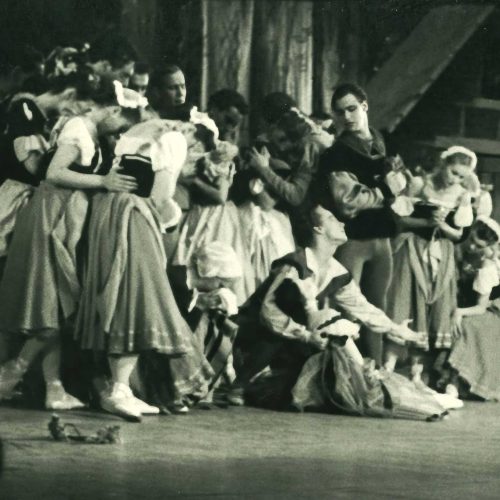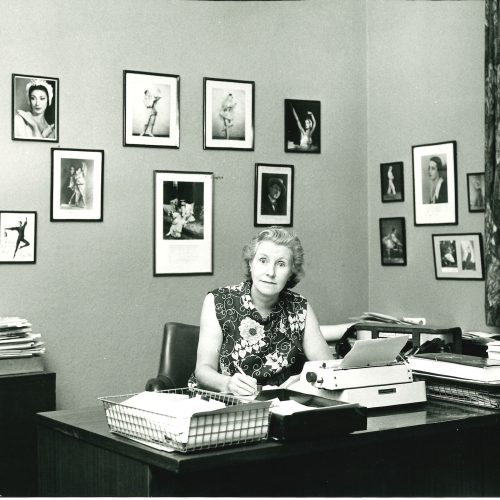Beryl Grey
Beryl Grey talks to Frank Freeman about her early training, first with Madeleine Sharp and then with Phyllis Bedells before going to the Sadler’s Wells School at the age of 10 in 1937. She joined the Sadler’s Wells Company when she was 14, and started performing leading ballerina roles almost straight away. She talks about this, and about touring during the war, before concluding with an account of the Company’s historic opening performance of Sleeping Beauty at Covent Garden in 1946.
The episode is introduced by a conversation with Darcey Bussell.
First published: May 20, 2025
Biography
Beryl Grey was born 1927 in Highgate, London. She began her ballet training at the age of four. At the age of 10, having passed all the Royal Academy of Dance examinations it was possible for her to take, she entered the Sadler’s Wells School. When she was 14, she joined the Sadler’s Wells Company, and almost immediately won leading roles. She danced a full Swan Lake on her fifteenth birthday and Giselle in 1944.
In 1957, she resigned from the Royal Ballet, and embarked on a new international career as a guest ballerina, including appearances with the Royal Ballet and (London) Festival Ballet. In 1957-8 she was the first English dancer to be honoured as a guest artist in Leningrad, at the Bolshoi in Moscow and in Tiflis [Tbilisi] . In 1964 she became the first Western guest artist to feature with the Peking Ballet and the Shanghai Company.
From 1968 – 1979 Beryl Grey was the Artistic Director of London Festival Ballet. She was President of English National Ballet, President of the Imperial Society of Teachers of Dancing and Vice-President of the Royal Academy of Dance. Her many honours include five honorary doctorates and the Queen Elizabeth II Coronation Award of the Royal Academy of Dance (in 1997). In 2016 she received the De Valois Award for Outstanding Achievement at the Critics’ Circle National Dance Awards. She was appointed C.B.E. in 1973, D.B.E. in 1988 and in 2017 was made a Companion of Honour (C.H) for services to dance.
Transcript
In conversation with Frank Freeman
Frank Freeman: Dame Beryl, when did you start dancing?
Beryl Grey: I suppose I could say when I was four. I did it at school as an extra.
Frank Freeman: Then, who were your first teachers?
Beryl Grey: Madeleine Sharp, an up and coming young teacher and in the end, as you know, she became one of the outstanding teachers of young children in the country. So I was just very lucky that she happened to teach at school. Within a year she asked my parents to bring me over to her school in Bromley. So I started, when I was about five, being a bit more serious about it all and I had 2 classes a week and then it was gradually built up. She used to take me up to Phyllis Bedells twice a year and I used to have six private lessons twice a year with Phyllis Bedells.
She’d arranged for me, when I was nine, because I couldn’t take any more exams, I was up to intermediate and you weren’t allowed to take the advanced with the RAD [Royal Academy of Dance] until you were 12. So she’d arranged for me to go up, they had a sort of scholarship scheme at that time and the examination was on a Monday and I got mumps on the Sunday, so I wasn’t allowed to go and I remember thinking it was the end of my dancing and I cried and cried. But, in fact, it was all to the good because after that she took me up to Sadler’s Wells for an interview there. It was Ursula Moreton taking the class and she said, yes, I could be accepted into the school; but the fees and everything were far too expensive for my parents. So then [Dame] Ninette [de Valois] auditioned me at a later stage and I was given this eight year contract: four years in the school, until I was 14, and then four years in the company, building up from ten shillings a week to four pounds a week when I was eighteen. That was the agreement. I’ve still got the agreement signed by Lilian Baylis and Ninette and I remember meeting Lilian Baylis twice.
Sheila McCarthy and [Nicholas] Sergeyev were my principal teachers to begin with, then Ursula Moreton and Ninette of course. About once a week, Ninette would come.
Frank Freeman: Could you just talk a little bit about Sergeyev and how his methods were…?
Beryl Grey: Oooh, he was very tough. He had a little cane, he would hit you with it on your legs. If you didn’t get your legs up high enough in développés and the knee was bent or the foot wasn’t stretched he would flick your leg or your foot. If your shoulders were up.
He was very funny with me. He used to call me “Burly Groom”, my real name is Groom you see. And he used to call me “Burly”, “Burly Groom”! And he knew it made me so cross. Ah, bless him! He was a great teacher. You had to do everything many, many times. I mean, you just didn’t do one développé, you did eight développés in front, eight to the back, eight to the side at the barre and in the centre you did everything about 12 times. And Ninette [de Valois] came in one day and decided that I was doing too much at my age, I was then only 10, and she wouldn’t let me do me all the repeat and everything for a year, which annoyed me, but never mind. You want, when you’re young to get in and do everything. She also took me off pointe for a year because I had done a little pointe work for the intermediate, in those days you did a little. So that was also, I felt, very retrograde, not being able to go en pointe. But as soon as I was 11 she let me do it all.
Frank Freeman: So when did you first enter the Vic Wells Ballet [later the Royal Ballet]? How old were you?
Beryl Grey: The school, I was ten; the company, I was fourteen. In July ’41 the first thing I ever did was Giselle corps de ballet.
Frank Freeman: Was that in both acts?
Beryl Grey: Yes, oh yes. They didn’t have many dancers in the war. So you had to do everything. In Sleeping Beauty, I did absolutely everything: I did Lilac Fairy Attendants, and then Garland Dance and then Hunting Ladies, quick change with your nymph costume underneath, and then in the last act whichever fairy-tale you were doing. I know every step of Sleeping Beauty.
And then I went back to school and within a week or so I was called up to Burnley to join the company because, I suppose, someone was ill. My parents saw me off at Rugby; arrived in Burnley expecting someone to meet me; there was no one at the station, so I walked to the theatre, which was shut, but there were stairs going up the back. So I went up this back staircase and, fortunately, the ballet mistress, Joy Newton, was there so then she took me off to some digs which were shared with someone called June Vincent. And June and I had to share a bed and the digs were 27 shillings and sixpence a week with cooked breakfast and cooked meal after the show at night. That was the cheapest digs I ever had. And we had to share a bed and I always remember June put this hard bolster down the middle so we didn’t wake each other up. That was my first week on tour.
One accepted what was going on around one. That’s the thing: in the war one didn’t have time to be frightened. Actually, the extraordinary thing about the Sadler’s Wells Company was, although we were often in towns which were bombed, nobody was ever hurt. I mean we were in Bath. We arrived on the Sunday after the first Baedeker raid and we were there for the Sunday night Baedeker raid and those were the only two raids there ever were on Bath and many of the digs, and that, had been bombed. Mine wasn’t, mine was all right. And Constant Lambert and Robbie, our stage manager, and three other chaps from the company slept in the Bath Opera House [Theatre Royal?] on the Sunday night and that had firebombs on it, so they helped put them out. Dear old Constant and Robbie, yes. And I remember there was always tremendous feeling between the orchestral players and the dancers who were naturally paid much more than the dancers. And some of the orchestral players, of course, they were in a hotel opposite where we were in digs, much cheaper. But the hotel was hit and none of them were hurt either. But we always used to think, well, serves them right for being able to afford a hotel and we couldn’t. I always remember one of the, I think it was a cellist, lost his false teeth and that was about the only tragedy of that bombing, yes.
No, we didn’t really have time to be scared. We worked. In those days there were no strict union rules, we in the theatre by 9.30 and class at 10. Rehearsed all day, most of the day; you could work right up to the half hour. Now, of course, you’re not allowed to do that. But we used to work very, very hard and they managed in the war, Ninette was just indestructible. If you look in Mary Clarke’s list of ballets in her book about Sadler’s Wells Ballet, the number of new works we put on in the war were incredible. And that was with rationing of clothes and everything like that. The ballet shoes we had one pair a fortnight and when you think we had 9 shows a week – I started doing solo roles within 6 months and leading roles within 9 months and still one pair of shoes every fortnight but I think about the end of ‘41 or the beginning of ‘42, the government actually said that our ballet shows wouldn’t go in rationing but of course they were very limited.
Frank Freeman: What other roles did you do?
Beryl Grey: After about 6 months we were doing Casse Noisette [The Nutcracker] in Cambridge and Moyra Fraser twisted her foot during the performance and I was sort of shouted at from the wings to go on and do her entrechat six solo and everything, which I did, and that’s when I did her Sabrina in Comus. So I started then doing her solo roles and then 3 months later when we were in Oxford, and Ninette had me in the office and she said, I want you to stop after class today and rehearse Swan Lake because you’ve got to do that this evening so I said, I thought you meant Big Swans because I was tall, I was at the back you see, by then I was tall and I was the back row of swans in the line, so I said, which side and she was furious, she said “Don’t be so silly dear, I mean the lead of course. You’ll do it with Bobby [Sir Robert Helpmann] tonight” and you know, I had never done any double work in my life and apparently on the last finger fouetté, I let go. But Bobby, being Bobby, caught me! I don’t know. Everybody’s face must have been aghast, but there we are. Yes, so I was really flung in the deep end, then. I did Les Sylphides that week, the lead, the pas de deux and I did Margot’s Comus.
Frank Freeman: And how old were you?
Beryl Grey: I was still 14 . And then, Madam [Ninette de Valois] was obviously pleased with Act 2 and she spent three months training me in Act 3 and Act 4 – and I did that, the whole of Swan Lake on my 15th birthday at the New which was lovely. And then I started to learn Giselle and I did my first Giselles in Hammersmith, in the theatre that’s now pulled down, with Bobby. I did two in one day actually my first Giselles I did a matinée and an evening, Yes, both with Bobby.
Frank Freeman: So you got through the war years and Dame Beryl could you just talk about the opening night of Sleeping Beauty and the lead up to that?
Beryl Grey: That was very exciting. I always felt that Ninette [de Valois] wasn’t 100% about going in there [Covent Garden]. I think it was Fred [Ashton] who seemed so terribly keen and Ninette was almost, I think very conscious of having been with [Sergei] Diaghilev how important temperament was and projection. And she always used to keep saying to us at the Garden you’ve got to project: you’ve got to not use your face alone you’ve got to project with your entire body, your back, your front, your side. And when we got onto the stage to rehearse, which wasn’t very early on, really, we didn’t have a lot of time to rehearse on the stage, she was always saying: “Project! Project! Project! We’ve got no meaning in the movement!”
The opening night was incredible because nothing was really finished. [Oliver] Messel’s dresses, which were so beautiful and so ornate, I mean, I was sewing on pieces of lilac right through the performance, you know, in the intervals, you know, we all were. Every dress was exquisite and had all these lovely pieces that had to be sewn on.
For us, it was a great experience because they used the ability at Covent Garden to lower and raise the stage so that, in the Prologue, we all entered from below the level of the stage from the back and came up the staircase, which in itself was terribly exciting because you came up and there was these, you know, beautiful sets, and the lights and ah, it was sensational, really. But I suppose the greatest thing about going into Covent Garden was going through the Stage Door and realising that all these great artists Baronova and Toumanova, Preobrajenska … they’d all danced there and then we were going to be in the same theatre on the same stage. I mean, it was a bit like going into church and it still is to me. I still think Covent Garden is the most wonderful, sacred place.
The transcript of this podcast may have been lightly edited for ease of reading.

